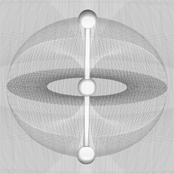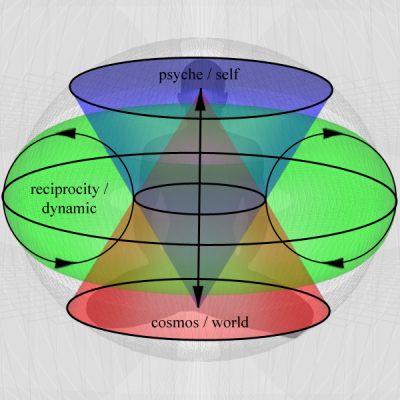




































representational inquiry regarding meaning » reality
The basic symbol for the Project's I-phase is a vertical axis. The axis, with its three nodes, represents the unity of the three terms about which the Project revolves: experiencer-experiencing-experienced. The axis isn't substantial. It's not as if there's a solid axel at the center of the system. This is why the axis is represented by a center line and not a line segment. There's nothing (substantial) there. The center line axis merely indicates the presence of a point of zero dimension where experiencer-experiencing-experienced collapse into experience as such (experience of nothing in particular). Said another way, the axis doesn't represent a particular ideology or set of beliefs that Project participants must accept; the system is non-ideological. The axis indicates the presence of open-ended questions.
Another way to conceive of the axis is in terms of directionality, as an arrow or arrows. As applied to the A-phase, for example, the axis is an arrow indicating purposive activity, pointing from the past (beneath/below) to the future (before/above). It represents the directionality of living life. As functioning in the I-phase, there are two superimposed arrows (⥮). Self and world are not dichotomous. They're not polar opposites, pointing away from each other. They point in opposite directions—not away from each other or toward one another—but as superimposed, interpenetrating by equal measure, representing their complete interdependence.
This interpenetration can be seen in the image to the right: the vertically-oriented blue and red cones that represent experiencer/self and experienced/world interpenetrate. The green torus indicates their dynamic relationship.

The letter I resembles the vertical axis about which this Project turns, and so it's used to represent the phase of the Project's tree when folded up as an axis.
Originally, the letter I (yod) depicted a hand, or arm with hand. Hands have been connected with rationality (see Aristotle, Parts of animals [687a2-687a23] and Gallagher, S. (2018) Embodied rationality. In G. Bronner & F. Di Iorio, eds. The mystery of rationality, pp. 83-94 [Springer]). This connection is appropriate since this Project's I-phase concerns the ideal (ideational), thus rational, dimension of experience. We speak of grasping ideas as well as grasping objects with our hands. "If we wish to convey that we have acquired something mental, we say that we have grasped it" —Révész, G. (1943) The human hand: A psychological study [J. Cohen, trans. Routledge & Kegan Paul 1958]. (See also—apprehend.) Moreover, I as hand is intimately related to O as eye in the hand-eye coordination critical for sense-making/embodied cognition.
Symbolically, I (yod/iota) is a seed of potential. It's pure, unactualized, unmanifest potential. An abstract/virtual axis locates this potential relative to manifest reality. I's potential actualizes in O (symbolically the ovum/soil).
Meaning is relational, so reality understood in terms of meaning involves a dynamic relationship between self and world. What reality means is a function of that relationship. If self and world are out-of-sync with each other, all seems lost in meaningless strife. When self and world are in-sync, however, harmony prevails and possibilities are freely explored. We might imagine self and world as two points (or poles) on an axis, and so we might use the axis as a symbol for talking about the degree to which self and world resonate. When the axis wobbles irregularly, self and world often find themselves in conflict—a chaotic conflict that projects no path to resolution. When the axis remains upright, spinning like a top, self and world ring with resonance. In either case, the axis defines their essential connectivity. The points on our axis (self and world) are interdependent and exist only in relation to each other as connected by an axis.
We might alternately think of this axis as an illustration of our self-control, our command over our own attention, the quality of our intentions and inclinations, our uprightness, the power of our will, our potential, the extent of our temporal horizon, and many other things. With self-control, our potential increases as it becomes engaged in worlds beyond the one of our immediate situation. We connect ourselves to a larger story and see its through-line even as we see the part we play in it. As our command over out own attention, the axis operates as the force by which an imbalance in our attention self-corrects—like the gyroscopic effect of a toy top that keeps it from falling. This effect is reinforced by the healthy balance of our attention to the subjective, objective, and active modes of attending to an experience at a particular level. Levels are themselves determined by the duration of the experience, hence thinking of the axis in terms of temporality. To keep an eye on that experience that is always present (the fundamental wonder of existence) even as we simulteneously enjoy experiences that come and go also helps us to retain harmony with the world. Indeed, attending to that non-particular experience that is always present with all other expereinces is to attend to, and so to strengthen, the axis itself.
